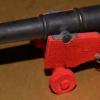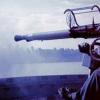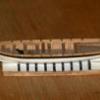MORE HANDBOOKS ARE ON THEIR WAY! We will let you know when they get here.
×
-
Posts
1,763 -
Joined
-
Last visited
Reputation Activity
-
 Mark P got a reaction from jud in Cleats
Mark P got a reaction from jud in Cleats
Hi YT;
A cleat in this context is a metal or wood object which is used to make fast (belay) a rope from the running rigging, so that whatever is at the other end of the rope will not move.
They come in all sorts of sizes. Think of something like the top of a longhorn steer's skull with the horns poking out to each side, both in a straight line.
The rope is passed under the horns, and over the middle, around and around in a figure-of-eight pattern.
They were fixed to the ships' sides, to the masts, or to the shrouds (this latter type are called shroud cleats)
A cleat is also the name for a small timber batten, used to hold something in place.
All the best,
Mark P
-
 Mark P got a reaction from EricWilliamMarshall in Block sizes
Mark P got a reaction from EricWilliamMarshall in Block sizes
During a recent visit to Portsmouth, I walked through a gallery dedicated to the tools and equipment used by many of the traditional dockyard trades, and saw this board on the wall. I would believe from the style of lettering that it dates to the early 1800s, perhaps a little earlier or later.
However, I would think that the information contained therein is unlikely to have changed very much at all from that of the times many decades previous to this.
The photos are large files, and should expand considerably when clicked. There is a lot of useful information here!
All the best,
Mark P
-
 Mark P got a reaction from thibaultron in Block sizes
Mark P got a reaction from thibaultron in Block sizes
During a recent visit to Portsmouth, I walked through a gallery dedicated to the tools and equipment used by many of the traditional dockyard trades, and saw this board on the wall. I would believe from the style of lettering that it dates to the early 1800s, perhaps a little earlier or later.
However, I would think that the information contained therein is unlikely to have changed very much at all from that of the times many decades previous to this.
The photos are large files, and should expand considerably when clicked. There is a lot of useful information here!
All the best,
Mark P
-
 Mark P got a reaction from mtaylor in Block sizes
Mark P got a reaction from mtaylor in Block sizes
During a recent visit to Portsmouth, I walked through a gallery dedicated to the tools and equipment used by many of the traditional dockyard trades, and saw this board on the wall. I would believe from the style of lettering that it dates to the early 1800s, perhaps a little earlier or later.
However, I would think that the information contained therein is unlikely to have changed very much at all from that of the times many decades previous to this.
The photos are large files, and should expand considerably when clicked. There is a lot of useful information here!
All the best,
Mark P
-
 Mark P got a reaction from dashi in Mast Lengths and their above deck heights for HMB Endeavour
Mark P got a reaction from dashi in Mast Lengths and their above deck heights for HMB Endeavour
Good Evening All;
This is part of the draught referred to. I won't post it all for copyright reasons.
I checked, and it actually says 'taken off in the single dock', not the wet dock. Memory plays up a bit, sometimes!
It is definitely dated as mentioned, though.
All the best,
Mark P
-
 Mark P got a reaction from mtaylor in Hermione cannon rigging
Mark P got a reaction from mtaylor in Hermione cannon rigging
Good Evening Spike;
I wish you all the best with completing your model.
The tackle at the rear is called the train tackle. When the cannon was fired, its recoil pushed it back within board. It needed to stay in that position while it was swabbed and reloaded. This was where the train tackle came into use. During this operation, it was kept taut so that if the deck heeled down towards the gun-port, the cannon would not roll while the crew were working on it.
Once reloaded, the train tackle was un-hooked, and the gun-tackles (the ones on each side) were used to run the gun out ready for firing.
Train tackles were not always issued as part of the gunner's stores, and even when available, were not always issued at the rate of one per gun.
Concerning the breeching, I know little of French practice, but it looks from the illustration as though the breeching passes through the sides of the gun-carriage, which, as you say, is very different to English methods. I remember some other contributors here posting pictures of a replica ship, Danish I think, which was breeched in the same manner. I believe it was Tadeusz.
All the best,
Mark P
-
 Mark P got a reaction from paulsutcliffe in Mast Lengths and their above deck heights for HMB Endeavour
Mark P got a reaction from paulsutcliffe in Mast Lengths and their above deck heights for HMB Endeavour
Good Morning Druxey;
Yes, it is not the same, although I think that the details shown are very similar to at least one of the draughts shown in earlier posts.
The date is very specific, which is helpful.
Shipaholic, I agreed that my visit to the Library was for personal research. I cannot therefore post more pictures here, as who knows what may then happen to them. The Library staff were extremely helpful, though, and would be willing to take a digital scan and send it. This would avoid the photographic distortion present in my pictures.
However, very inconveniently, they are now in the process of moving to different premises, and are very unlikely to reply to any emails, for many months. Which is not helpful.
All the best,
Mark P
-
 Mark P got a reaction from paulsutcliffe in Mast Lengths and their above deck heights for HMB Endeavour
Mark P got a reaction from paulsutcliffe in Mast Lengths and their above deck heights for HMB Endeavour
Good Evening Everyone;
I recently visited the Naval Base at Portsmouth, with the kind assistance of the staff of the Library of the National Museum of the Royal Navy and the Librarians of the Admiralty Library, to view a variety of interesting documents. One of these was a draught of 'HM Bark Endeavour', described as 'taken off in the wet dock' and dated 25th April 1768. This lists her principal dimensions, and there is another word near the date, hard to read, of four letters, but it might say '?rey', which I would take to read 'Grey', as mentioned in previous posts, except that the 'r' looks more like a 'p', which would read '?pey' and I can't make much sense of that.
Interestingly, this draught shows a tall, built up companion immediately afore the wheel, and a variety of dashed lines for the position of the rails and lengths of the mizzen channels.
I will post a picture of part of her here, as it seems that it is not presently known widely, and it may be of use to modellers of the Endeavour. I don't have time right now to edit the picture, but I will do this tomorrow.
All the best,
Mark P
-
 Mark P got a reaction from paulsutcliffe in Mast Lengths and their above deck heights for HMB Endeavour
Mark P got a reaction from paulsutcliffe in Mast Lengths and their above deck heights for HMB Endeavour
Good Evening All;
This is part of the draught referred to. I won't post it all for copyright reasons.
I checked, and it actually says 'taken off in the single dock', not the wet dock. Memory plays up a bit, sometimes!
It is definitely dated as mentioned, though.
All the best,
Mark P
-
 Mark P got a reaction from druxey in Mast Lengths and their above deck heights for HMB Endeavour
Mark P got a reaction from druxey in Mast Lengths and their above deck heights for HMB Endeavour
Good Evening Everyone;
I recently visited the Naval Base at Portsmouth, with the kind assistance of the staff of the Library of the National Museum of the Royal Navy and the Librarians of the Admiralty Library, to view a variety of interesting documents. One of these was a draught of 'HM Bark Endeavour', described as 'taken off in the wet dock' and dated 25th April 1768. This lists her principal dimensions, and there is another word near the date, hard to read, of four letters, but it might say '?rey', which I would take to read 'Grey', as mentioned in previous posts, except that the 'r' looks more like a 'p', which would read '?pey' and I can't make much sense of that.
Interestingly, this draught shows a tall, built up companion immediately afore the wheel, and a variety of dashed lines for the position of the rails and lengths of the mizzen channels.
I will post a picture of part of her here, as it seems that it is not presently known widely, and it may be of use to modellers of the Endeavour. I don't have time right now to edit the picture, but I will do this tomorrow.
All the best,
Mark P
-
 Mark P got a reaction from dashi in Mast Lengths and their above deck heights for HMB Endeavour
Mark P got a reaction from dashi in Mast Lengths and their above deck heights for HMB Endeavour
Good Evening Everyone;
I recently visited the Naval Base at Portsmouth, with the kind assistance of the staff of the Library of the National Museum of the Royal Navy and the Librarians of the Admiralty Library, to view a variety of interesting documents. One of these was a draught of 'HM Bark Endeavour', described as 'taken off in the wet dock' and dated 25th April 1768. This lists her principal dimensions, and there is another word near the date, hard to read, of four letters, but it might say '?rey', which I would take to read 'Grey', as mentioned in previous posts, except that the 'r' looks more like a 'p', which would read '?pey' and I can't make much sense of that.
Interestingly, this draught shows a tall, built up companion immediately afore the wheel, and a variety of dashed lines for the position of the rails and lengths of the mizzen channels.
I will post a picture of part of her here, as it seems that it is not presently known widely, and it may be of use to modellers of the Endeavour. I don't have time right now to edit the picture, but I will do this tomorrow.
All the best,
Mark P
-
 Mark P got a reaction from Canute in Hermione cannon rigging
Mark P got a reaction from Canute in Hermione cannon rigging
Good Evening Spike;
I wish you all the best with completing your model.
The tackle at the rear is called the train tackle. When the cannon was fired, its recoil pushed it back within board. It needed to stay in that position while it was swabbed and reloaded. This was where the train tackle came into use. During this operation, it was kept taut so that if the deck heeled down towards the gun-port, the cannon would not roll while the crew were working on it.
Once reloaded, the train tackle was un-hooked, and the gun-tackles (the ones on each side) were used to run the gun out ready for firing.
Train tackles were not always issued as part of the gunner's stores, and even when available, were not always issued at the rate of one per gun.
Concerning the breeching, I know little of French practice, but it looks from the illustration as though the breeching passes through the sides of the gun-carriage, which, as you say, is very different to English methods. I remember some other contributors here posting pictures of a replica ship, Danish I think, which was breeched in the same manner. I believe it was Tadeusz.
All the best,
Mark P
-
 Mark P got a reaction from Fright in Hermione cannon rigging
Mark P got a reaction from Fright in Hermione cannon rigging
Good Evening Spike;
I wish you all the best with completing your model.
The tackle at the rear is called the train tackle. When the cannon was fired, its recoil pushed it back within board. It needed to stay in that position while it was swabbed and reloaded. This was where the train tackle came into use. During this operation, it was kept taut so that if the deck heeled down towards the gun-port, the cannon would not roll while the crew were working on it.
Once reloaded, the train tackle was un-hooked, and the gun-tackles (the ones on each side) were used to run the gun out ready for firing.
Train tackles were not always issued as part of the gunner's stores, and even when available, were not always issued at the rate of one per gun.
Concerning the breeching, I know little of French practice, but it looks from the illustration as though the breeching passes through the sides of the gun-carriage, which, as you say, is very different to English methods. I remember some other contributors here posting pictures of a replica ship, Danish I think, which was breeched in the same manner. I believe it was Tadeusz.
All the best,
Mark P
-

-
 Mark P got a reaction from Landlubber Mike in Line of gratings along open waist of Euromodel's La Renommee - flush or above deck?
Mark P got a reaction from Landlubber Mike in Line of gratings along open waist of Euromodel's La Renommee - flush or above deck?
Hi Mike;
I know that La Renommee is a bit later in time, but a very common phrase in ship-building contracts from the late 17th century/early 18th, related to gratings, is that they are 'to vent the smoake (sic) of the ordnance'.
The gratings, if this is their purpose, are therefore designed for something moving upwards, not downwards.
Although the waist is open, I would suggest that a fully planked gangway over the cannon would hinder the escape of the smoke, so the above hypothesis is reasonable. In this case, the prime function of the gangways would be for sailors to walk along. with this in mind, flush gratings would seem most likely.
All the best,
Mark P
-
 Mark P got a reaction from paulsutcliffe in Line of gratings along open waist of Euromodel's La Renommee - flush or above deck?
Mark P got a reaction from paulsutcliffe in Line of gratings along open waist of Euromodel's La Renommee - flush or above deck?
Hi Mike;
I know that La Renommee is a bit later in time, but a very common phrase in ship-building contracts from the late 17th century/early 18th, related to gratings, is that they are 'to vent the smoake (sic) of the ordnance'.
The gratings, if this is their purpose, are therefore designed for something moving upwards, not downwards.
Although the waist is open, I would suggest that a fully planked gangway over the cannon would hinder the escape of the smoke, so the above hypothesis is reasonable. In this case, the prime function of the gangways would be for sailors to walk along. with this in mind, flush gratings would seem most likely.
All the best,
Mark P
-
 Mark P got a reaction from BETAQDAVE in Cleats
Mark P got a reaction from BETAQDAVE in Cleats
Hi YT;
A cleat in this context is a metal or wood object which is used to make fast (belay) a rope from the running rigging, so that whatever is at the other end of the rope will not move.
They come in all sorts of sizes. Think of something like the top of a longhorn steer's skull with the horns poking out to each side, both in a straight line.
The rope is passed under the horns, and over the middle, around and around in a figure-of-eight pattern.
They were fixed to the ships' sides, to the masts, or to the shrouds (this latter type are called shroud cleats)
A cleat is also the name for a small timber batten, used to hold something in place.
All the best,
Mark P
-
 Mark P got a reaction from gerty in Cleats
Mark P got a reaction from gerty in Cleats
Hi YT;
A cleat in this context is a metal or wood object which is used to make fast (belay) a rope from the running rigging, so that whatever is at the other end of the rope will not move.
They come in all sorts of sizes. Think of something like the top of a longhorn steer's skull with the horns poking out to each side, both in a straight line.
The rope is passed under the horns, and over the middle, around and around in a figure-of-eight pattern.
They were fixed to the ships' sides, to the masts, or to the shrouds (this latter type are called shroud cleats)
A cleat is also the name for a small timber batten, used to hold something in place.
All the best,
Mark P
-
 Mark P got a reaction from Canute in Cleats
Mark P got a reaction from Canute in Cleats
Hi YT;
A cleat in this context is a metal or wood object which is used to make fast (belay) a rope from the running rigging, so that whatever is at the other end of the rope will not move.
They come in all sorts of sizes. Think of something like the top of a longhorn steer's skull with the horns poking out to each side, both in a straight line.
The rope is passed under the horns, and over the middle, around and around in a figure-of-eight pattern.
They were fixed to the ships' sides, to the masts, or to the shrouds (this latter type are called shroud cleats)
A cleat is also the name for a small timber batten, used to hold something in place.
All the best,
Mark P
-

-
 Mark P got a reaction from mtaylor in Hello from Nottingham!
Mark P got a reaction from mtaylor in Hello from Nottingham!
Hi James;
That is indeed an impressive array of models.
I presume that you have seen the large model of King George V in the NMM. Wouldn't quite fit on a cupboard, though!
All the best with your modelling.
Mark P
-
 Mark P got a reaction from Old Collingwood in Hello from Nottingham!
Mark P got a reaction from Old Collingwood in Hello from Nottingham!
Hi James;
That is indeed an impressive array of models.
I presume that you have seen the large model of King George V in the NMM. Wouldn't quite fit on a cupboard, though!
All the best with your modelling.
Mark P
-
 Mark P got a reaction from mtaylor in Cleats
Mark P got a reaction from mtaylor in Cleats
Hi YT;
A cleat in this context is a metal or wood object which is used to make fast (belay) a rope from the running rigging, so that whatever is at the other end of the rope will not move.
They come in all sorts of sizes. Think of something like the top of a longhorn steer's skull with the horns poking out to each side, both in a straight line.
The rope is passed under the horns, and over the middle, around and around in a figure-of-eight pattern.
They were fixed to the ships' sides, to the masts, or to the shrouds (this latter type are called shroud cleats)
A cleat is also the name for a small timber batten, used to hold something in place.
All the best,
Mark P
-

-





.thumb.jpeg.fc5d633a7b34428fcf19419a73d56d55.jpeg)








